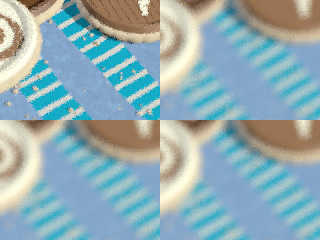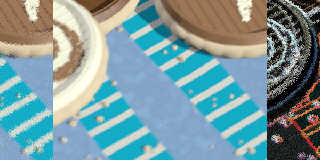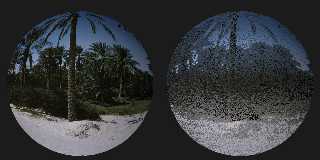|
 |
On 11/3/20 10:43 AM, William F Pokorny wrote:
> On 11/3/20 7:29 AM, Le_Forgeron wrote:
>> Le 31/10/2020 à 13:23, William F Pokorny a écrit :
>>
>> How does it interact with bokey ?
>>
...
>
> I'll try and get back and do some bokeh renders this afternoon. Thanks
> again for the question!
>
Ended some time yesterday and more this morning...
---
My look at bokeh with idea of looking at AA big jitter in combination.
Basically, after quite a bit of time, I'm not quite sure what bokeh is
doing beyond shaping somewhat the sampling pattern. Further, in all my
testing big jitter overwhelms the bokeh effect.
If anyone has a really good example scene of bokeh usage where the
effect is working really well, I'd be interested. Quite a bit with that
feature looks funky to me, but maybe I just don't understand it well
enough? Do I not the right sort of in focus versus way out of focus set up?
Stuff that look weird:
no bokeh -> 4289148 rays
1/3 in x white -> 3143459 rays
All white image -> 3002417 rays
All black image -> 3282071 rays
... Why is no bokeh so much larger than any bokeh result. Do I need a
big min samples or something? My assumption is it should still converge
to the confidence value using up to the max samples, but within the
shape and all white should always have more samples than black (no shape)?
The larger the user's number of samples the smaller the bokeh jitter in
the created jitter array. This a bit like the AA jitter value shrinking
as the recursion deepens no matter the threshold/confidence and adaptation.
Any time I try to use anything but an image_map in the pigment I get a
core dump.
There is some unfinished code in the bokeh conditional which should
probably be finished.
Attached is bokehShift.jpg. The sample size is set to 1 so the bokeh
jitter values are as large as possible. On the left bokeh with a
completely black image. On the right the completely white image. There
is a significant shift down and to the left where the image is white (or
visa versa). And both white and black are shifted relative to simple
focal blur. No image for this latter lessor shift - though it is buried
in the image bokehShift.jpg image differences.
Also attached is a second image in blurSmplOne.jpg trying to answer your
question, Jerome, FWIW. In the upper left focual blur at 1 sample. In
the upper right is just "+a0.0 +am1 +r4 +j222". In the lower left corner
both together but no bokeh. In the lower right focal blur one sample,
jitter 222, and a bokeh pattern (image) with a vertical white stripe in
the middle third. There is change, but it's overwhelmed by the random
big jitter.
Expect I could figure out more, but I'm not doing it now... And, if
ever, I'd like to start with a good "working" example of bokeh use. Oh,
and maybe a good description of the expected inner code behavior should
be if that exists in someone's library?
Bill P.
Post a reply to this message
Attachments:
Download 'blursmplone.jpg' (149 KB)
Download 'bokehshift.jpg' (177 KB)
Preview of image 'blursmplone.jpg'

Preview of image 'bokehshift.jpg'

|
 |
|
 |
On 10/31/20 8:23 AM, William F Pokorny wrote:
...
>
> Thinking some of increasing the max allowed depth for AA method 1 to
> perhaps 20. Also of trying again my isosurface cloud renders with jitter
> values >>1.0....
>
I've updated povr's AA and jitter code to support method 1 +r depths of
whatever size. Left the other two methods alone.
Also made some updates to avoid extra work where the threshold is
essentially zero or the aagamma (+ag) is 1.0. This lets one bypass the
gamma curve corrections and use just threshold for control. One can get
substantial render savings. One can also get longer renders. Amounts to
more control and an ability to get time savings when the curve
corrections and threshold tests are just useless computations toward an
end result.
One other thing I've learned is the big jitter makes the method 1
testing left and up only bias more obvious. For symmetry in AA results
methods 2 and 3 are the way to go.
Lastly, attaching another example showing an odd effect one can get with
very big jitter settings and largish threshold settings. Basically the
big jitter only kicks in near where AA does. Not sure if the result
would ever be that useful, but FWIW.
Bill P.
Post a reply to this message
Attachments:
Download 'bigjitthrspt15.jpg' (131 KB)
Preview of image 'bigjitthrspt15.jpg'

|
 |




![]()